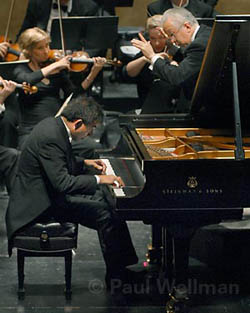The Santa Barbara Chamber Orchestra at the Lobero Theatre.
Last Hurrah
When Maestro Heiichiro Ohyama and pianist Max Levinson walked onstage together, they hardly paused before getting down to the business of ending the season. Appropriately enough, they chose the last work Beethoven ever performed with an orchestra: the Piano Concerto No. 4 in G major, Opus 58. The work is both a sad farewell by Beethoven to his performing career (he knew he was losing his hearing) and a heroic beginning of his achievement as the first major composer to make a living through composition alone. With a winning combination of boldness and sensitivity, Levinson and the Santa Barbara Chamber Orchestra allowed us to hear the complex beauty of this great turning point in music history.

The concerto begins with a few deceptively slow chords, which Levinson played with daring softness-almost below the threshold of hearing. When Maestro Ohyama picked up the tempo to allegro moderato, Levinson’s gamble paid off: The first theme came through boldly, and he had plenty of room to vary the dynamics throughout. Levinson also showed remarkable sensitivity to the fact that he was playing with a chamber orchestra, gracefully balancing the sound of the piano with individual instrumentalists, rather than whole sections. The andante and rondo: vivace movements revealed similar attention to balance, leading seamlessly from the quiet ending of the second movement (called “Orpheus Taming the Furies” by both Franz Liszt and musicologist A. B. Marx) to the triumphant finale.
After the intermission, Maestro Ohyama and the orchestra returned to give us Mendelssohn’s joyful “Italian” Symphony No. 4 in A Major, Opus 90. It’s hard to imagine how an audience could be surprised by such a familiar work, but clever, insightful conducting and energetic playing can work wonders-and this performance was wondrous. Sparkling phrases in the development of the first movement emerged as if from nowhere, opening our ears and making the piece new again. The second movement let us rest and meditate a bit; the third got us dancing the minuet with Mendelssohn’s characteristic light touch. But the fourth movement was wild-a combination of the saltarello and the tarantella, both
Italian dances, lifted us out of our seats. Thanks for a great season, Maestro Ohyama and the Santa Barbara Chamber Orchestra-we’re already looking forward to next year.



